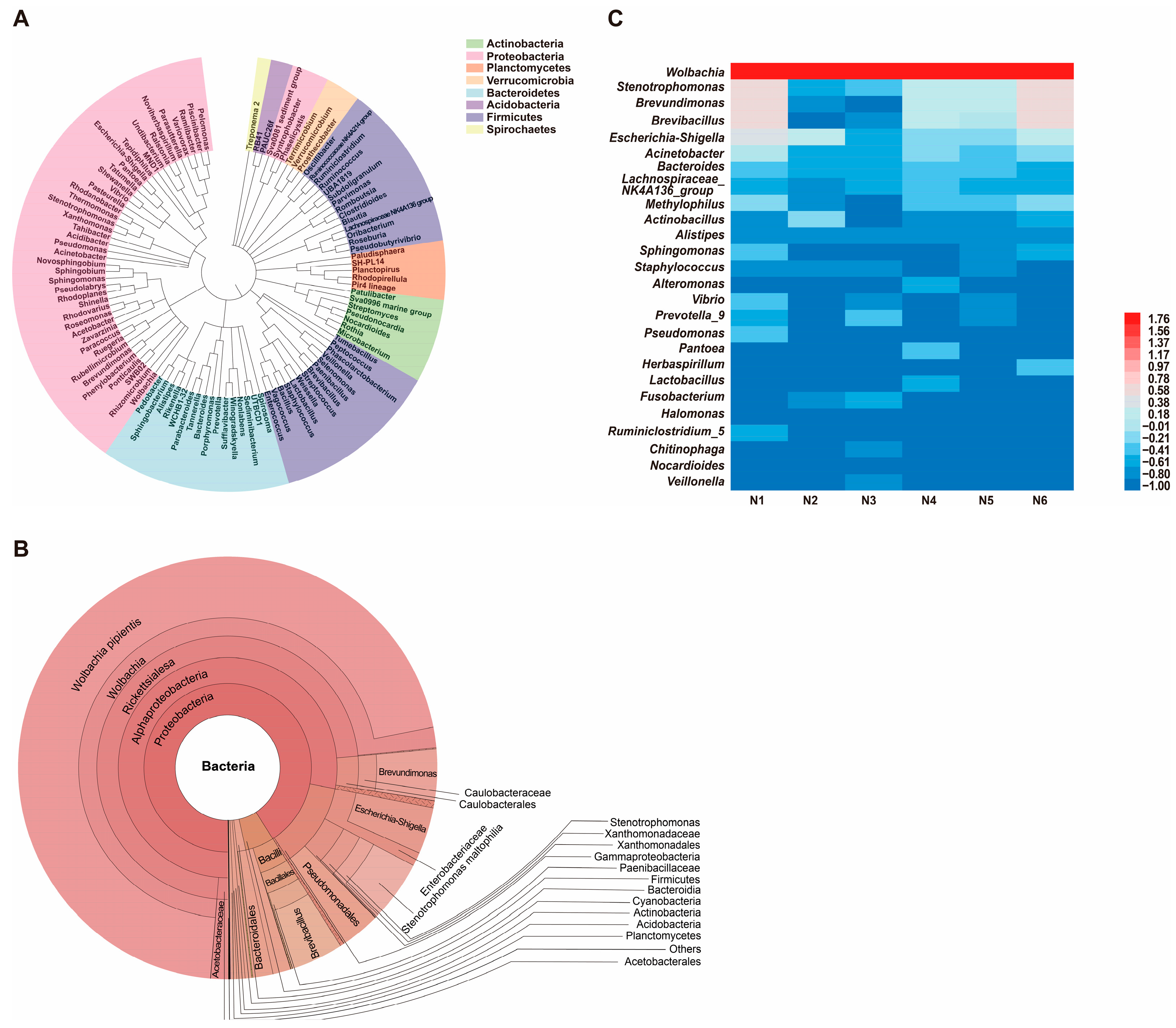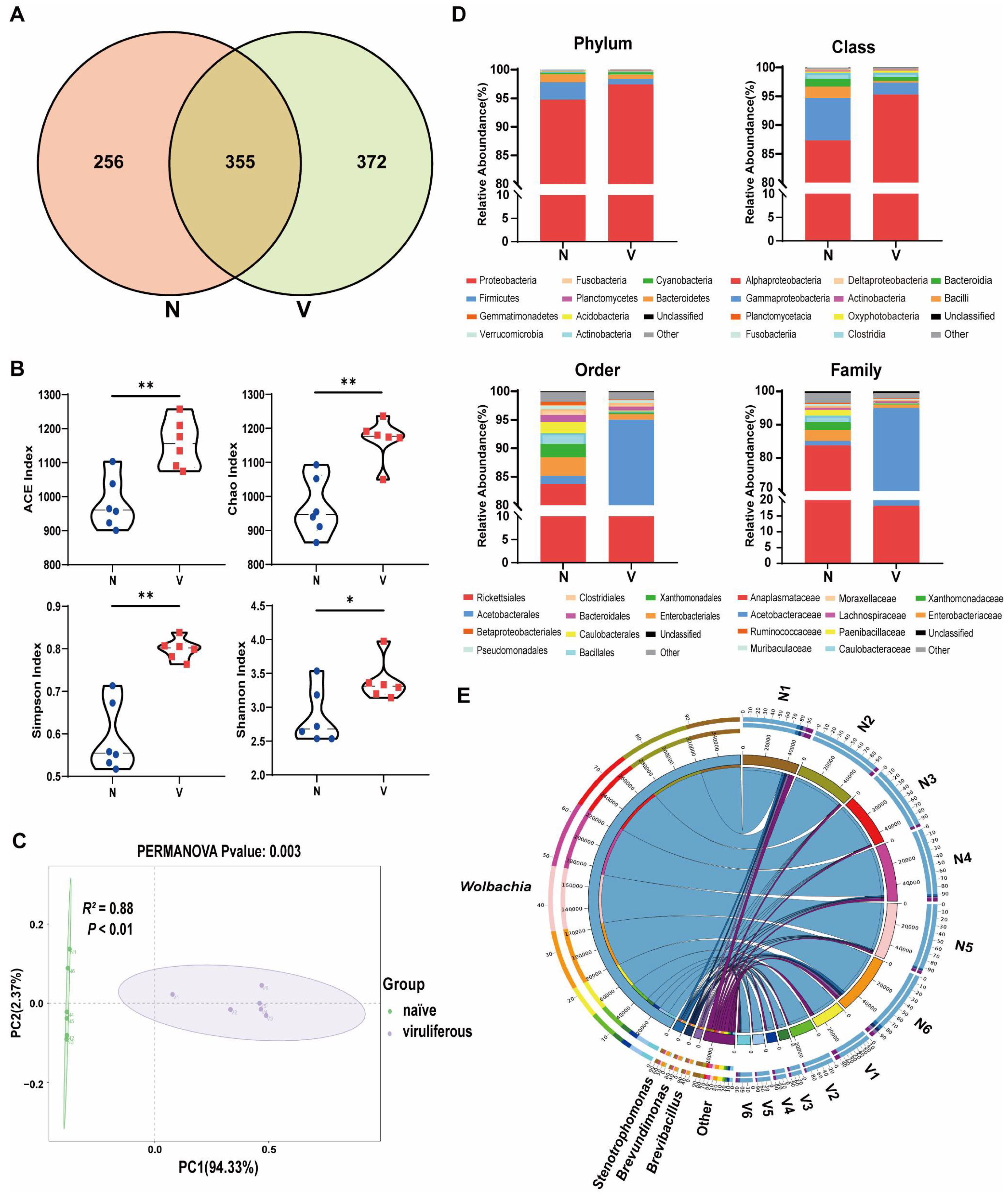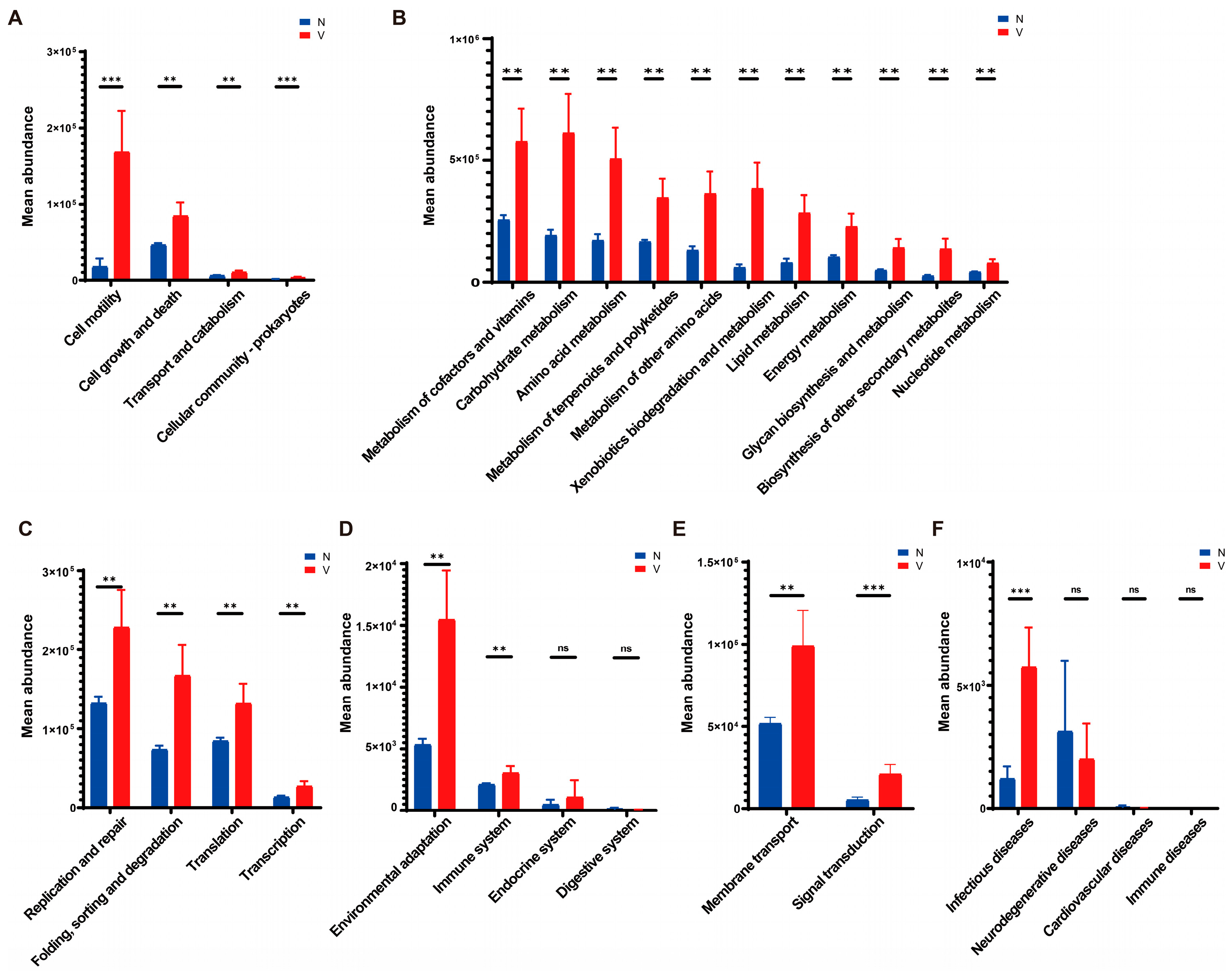Composition of the Gut Microbiome and Its Response to Rice Stripe Virus Infection in Laodelphax striatellus (Hemiptera: Delphacidae)
Simple Summary
Abstract
1. Introduction
2. Materials and Methods
2.1. Insect Rearing and Sample Preparation
2.2. Extraction of DNA and PCR Assays
2.3. Sequencing with Hiseq 2500
2.4. Sequence Data Processing and Bioinformatics Analysis
2.5. Enumeration of Microbes in the Gut Microbiota
3. Results
3.1. Composition and Diversity of Gut Microbiota in Naïve SBPH
3.2. Composition and Abundance of Gut Microbiota in Viruliferous and Naïve SBPH
3.2.1. Comparison of Gut Microbiota Composition
3.2.2. Comparison of Gut Microbiota Abundance
3.3. Comparison of Gut Microbial Loads in Viruliferous and Naïve SBPH
3.4. Predicted Functions of Gut Microbial Communities in Viruliferous and Naïve SBPH
4. Discussion
Author Contributions
Funding
Data Availability Statement
Conflicts of Interest
References
- Huang, Q.; Feng, Y.; Shan, H.W.; Chen, J.P.; Wu, W. A Novel Nitrogen-Fixing Bacterium Raoultella Electrica Isolated from the Midgut of the Leafhopper Recilia Dorsalis. Insects 2023, 14, 431. [Google Scholar] [CrossRef]
- Ceja-Navarro, J.A.; Karaoz, U.; Bill, M.; Hao, Z.; Iii, W.; Arellano, A.; Ramanculova, L.; Filley, T.R.; Berry, D.; Conrad, M.E.; et al. Gut anatomical properties and microbial functional assembly promote lignocellulose deconstruction and colony subsistence of a wood-feeding beetle. Nat. Microbiol. 2019, 4, 864–875. [Google Scholar] [CrossRef]
- Liu, F.; Ye, F.; Yang, Y.; Kang, Z.; Liu, Y.; Chen, W.; Wang, S.; Kou, H.; Kang, L.; Sun, J. Gut bacteria are essential for development of an invasive bark beetle by regulating glucose transport. Proc. Natl. Acad. Sci. USA 2024, 121, e2410889121. [Google Scholar] [CrossRef]
- Coon, K.L.; Valzania, L.; McKinney, D.A.; Vogel, K.J.; Brown, M.R.; Strand, M.R. Bacteria-mediated hypoxia functions as a signal for mosquito development. Proc. Natl. Acad. Sci. USA 2017, 114, E5362–E5369. [Google Scholar] [CrossRef]
- Jia, Y.; Jin, S.; Hu, K.; Geng, L.; Han, C.; Kang, R.; Pang, Y.; Ling, E.; Tan, E.K.; Pan, Y.; et al. Gut microbiome modulates Drosophila aggression through octopamine signaling. Nat. Commun. 2021, 12, 2698. [Google Scholar] [CrossRef]
- Zhang, Z.; Mu, X.; Cao, Q.; Shi, Y.; Hu, X.; Zheng, H. honeybee gut Lactobacillus modulates host learning and memory behaviors via regulating tryptophan metabolism. Nat. Commun. 2022, 13, 2037. [Google Scholar] [CrossRef]
- Wang, G.H.; Dittmer, J.; Douglas, B.; Huang, L.; Brucker, R.M. Coadaptation between host genome and microbiome under long-term xenobiotic-induced selection. Sci. Adv. 2021, 7, eabd4473. [Google Scholar] [CrossRef] [PubMed]
- Liu, G.; Cao, L.; Han, R. Plant quercetin degradation by gut bacterium Raoultella terrigena of ghost moth Thitarodes xiaojinensis. Front. Microbiol. 2022, 13, 1079550. [Google Scholar] [CrossRef] [PubMed]
- Peng, Y.; Wen, S.; Wang, G.; Zhang, X.; Di, T.; Du, G.; Chen, B.; Zhang, L. Reconstruction of gut bacteria in Spodoptera frugiperda infected by Beauveria bassiana affects the survival of host pest. J. Fungi 2023, 9, 906. [Google Scholar] [CrossRef]
- Turner, M. The gut microbiota confers resistance against Salmonella eyphimurium in cockroaches by modulating innate immunity. iScience 2024, 27, 111293. [Google Scholar] [CrossRef] [PubMed]
- Yin, C.; Sun, P.; Yu, X.; Wang, P.; Cheng, G. Roles of symbiotic microorganisms in arboviral infection of arthropod vectors. Trends Parasitol. 2020, 36, 607–615. [Google Scholar] [CrossRef]
- Wu, P.; Sun, P.; Nie, K.; Zhu, Y.; Shi, M.; Xiao, C.; Liu, H.; Liu, Q.; Zhao, T.; Chen, X.; et al. A gut commensal bacterium promotes mosquito permissiveness to arboviruses. Cell Host Microbe 2019, 25, 101–112. [Google Scholar] [CrossRef]
- Ma, Y.; Lu, H.; Wang, W.; Zhu, J.; Zhao, W.; Cui, F. Membrane Association of importin α facilitates viral entry into salivary gland cells of vector insects. Proc. Natl. Acad. Sci. USA 2021, 118, e2103393118. [Google Scholar] [CrossRef]
- Ramirez, J.L.; Souza-Neto, J.; Torres Cosme, R.; Rovira, J.; Ortiz, A.; Pascale, J.M.; Dimopoulos, G. Reciprocal tripartite interactions between the Aedes aegypti midgut microbiota, innate immune system and dengue virus influences vector competence. PLoS Negl. Trop. Dis. 2012, 6, e1561. [Google Scholar] [CrossRef] [PubMed]
- Yu, X.; Tong, L.; Zhang, L.; Yang, Y.; Xiao, X.; Zhu, Y.; Wang, P.; Cheng, G. Lipases secreted by a gut bacterium inhibit arbovirus transmission in mosquitoes. PLoS Pathog. 2022, 18, e1010552. [Google Scholar] [CrossRef] [PubMed]
- Zhang, L.; Wang, D.; Shi, P.; Li, J.; Niu, J.; Chen, J.; Wang, G.; Wu, L.; Chen, L.; Yang, Z.; et al. A naturally isolated symbiotic bacterium suppresses flavivirus transmission by Aedes mosquitoes. Science 2024, 384, eadn9524. [Google Scholar] [CrossRef] [PubMed]
- Heong, K.L.; Cheng, J. Rice Planthoppers: Ecology, Management, Socio Economics and Policy; Escalada, M.M., Ed.; Springer: Dordrecht, The Netherlands, 2015; pp. 33–63. ISBN 978-94-017-9534-0. [Google Scholar]
- Xu, Y.; Fu, S.; Tao, X.; Zhou, X. Rice stripe virus: Exploring Molecular Weapons in the Arsenal of a Negative-Sense RNA Virus. Annu. Rev. Phytopathol. 2021, 59, 351–371. [Google Scholar] [CrossRef]
- Li, Y.; Chen, D.; Hu, J.; Zhang, K.; Kang, L.; Chen, Y.; Huang, L.; Zhang, L.; Xiang, Y.; Song, Q.; et al. The α-Tubulin of Laodelphax striatellus mediates the passage of rice stripe virus (RSV) and enhances horizontal transmission. PLOS Pathog. 2020, 16, e1008710. [Google Scholar] [CrossRef]
- Zhang, X.; Li, T.; Zhou, C.; Zhao, D.; Zhu, Y.; Bing, X.; Huang, H.; Hong, X. antibiotic exposure perturbs the bacterial community in the small brown planthopper Laodelphax striatellus. Insect Sci. 2020, 27, 895–907. [Google Scholar] [CrossRef]
- Wang, Z.-L.; Pan, H.; Wu, W.; Li, M.-Y.; Yu, X.-P. The gut bacterial flora associated with brown planthopper is affected by host rice varieties. Arch. Microbiol. 2021, 203, 325–333. [Google Scholar] [CrossRef]
- Bokulich, N.A.; Subramanian, S.; Faith, J.J.; Gevers, D.; Gordon, J.I.; Knight, R.; Mills, D.A.; Caporaso, J.G. Quality-filtering vastly improves diversity estimates from Illumina amplicon sequencing. Nat. Methods 2013, 10, 57–59. [Google Scholar] [CrossRef]
- Kerr, K.G.; Denton, M.; Todd, N.; Corps, C.M.; Kumari, P.; Hawkey, P.M. A new selective differential medium for isolation of Stenotrophomonas maltophilia. Eur. J. Clin. Microbiol. Infect. Dis. 1996, 15, 607–610. [Google Scholar] [CrossRef]
- Reasoner, D.J.; Geldreich, E.E. A new medium for the enumeration and subculture of bacteria from potable water. Appl. Environ. Microbiol. 1985, 49, 1–7. [Google Scholar] [CrossRef] [PubMed]
- Edwards, S.G.; Seddon, B. Selective medium based on tyrosine metabolism for the isolation and enumeration of Brevibacillus brevis (Bacillus brevis). Lett. Appl. Microbiol. 2000, 31, 395–399. [Google Scholar] [CrossRef]
- Muwonge, K.M.; Ndagire, H.; Mulindwa, J.; Twesigye, C.K. Multiple antimicrobial resistance indices of Staphylococcus aureus from the nares of goats and slaughterhouse attendants in Kampala city, Uganda—A cross sectional study. BMC Microbiol. 2025, 25, 162. [Google Scholar] [CrossRef]
- Campbell, D.E.; Li, Y.; Ingle, H.; Baldridge, M.T. Impact of the Microbiota on Viral Infections. Annu. Rev. Virol. 2023, 10, 371–395. [Google Scholar] [CrossRef] [PubMed]
- Salem, H.; Kreutzer, E.; Sudakaran, S.; Kaltenpoth, M. A ctinobacteria as essential symbionts in firebugs and cotton stainers (Hemiptera, Pyrrhocoridae). Environ. Microbiol. 2013, 15, 1956–1968. [Google Scholar] [CrossRef]
- Seabourn, P.; Spafford, H.; Yoneishi, N.; Medeiros, M. The Aedes albopictus (Diptera: Culicidae) microbiome varies spatially and with Ascogregarine infection. PLoS Negl. Trop. Dis. 2020, 14, e0008615. [Google Scholar] [CrossRef]
- Bing, X.; Zhao, D.; Peng, C.; Huang, H.; Hong, X. Similarities and spatial variations of bacterial and fungal communities in field rice planthopper (Hemiptera: Delphacidae) populations. Insect Sci. 2020, 27, 947–963. [Google Scholar] [CrossRef]
- Righi, E.; Dalla Vecchia, I.; Auerbach, N.; Morra, M.; Górska, A.; Sciammarella, C.; Lambertenghi, L.; Gentilotti, E.; Mirandola, M.; Tacconelli, E.; et al. Gut Microbiome Disruption Following SARS-CoV-2: A Review. Microorganisms 2024, 12, 131. [Google Scholar] [CrossRef]
- Harris, V.C.; Haak, B.W.; Handley, S.A.; Jiang, B.; Velasquez, D.E.; Hykes, B.L.; Droit, L.; Berbers, G.A.M.; Kemper, E.M.; Van Leeuwen, E.M.M.; et al. Effect of Antibiotic-Mediated Microbiome Modulation on Rotavirus Vaccine Immunogenicity: A Human, Randomized-Control Proof-of-Concept Trial. Cell Host Microbe 2018, 24, 197–207.e4. [Google Scholar] [CrossRef]
- Deriu, E.; Boxx, G.M.; He, X.; Pan, C.; Benavidez, S.D.; Cen, L.; Rozengurt, N.; Shi, W.; Cheng, G. Influenza Virus Affects Intestinal Microbiota and Secondary Salmonella Infection in the Gut through Type I Interferons. PLoS Pathog. 2016, 12, e1005572. [Google Scholar] [CrossRef]
- Shin, S.C.; Kim, S.-H.; You, H.; Kim, B.; Kim, A.C.; Lee, K.-A.; Yoon, J.-H.; Ryu, J.-H.; Lee, W.-J. Drosophila microbiome modulates host developmental and metabolic homeostasis via insulin signaling. Science 2011, 334, 670–674. [Google Scholar] [CrossRef]
- Pimentel, A.C.; Cesar, C.S.; Martins, M.; Cogni, R. The Antiviral Effects of the Symbiont Bacteria Wolbachia in Insects. Front. Immunol. 2021, 11, 626329. [Google Scholar] [CrossRef]
- Pimentel, A.C.; Cesar, C.S.; Martins, A.H.B.; Martins, M.; Cogni, R. Wolbachia Offers Protection Against Two Common Natural Viruses of Drosophila. Microb. Ecol. 2025, 88, 24. [Google Scholar] [CrossRef]
- Moreira, L.A.; Iturbe-Ormaetxe, I.; Jeffery, J.A.; Lu, G.; Pyke, A.T.; Hedges, L.M.; Rocha, B.C.; Hall-Mendelin, S.; Day, A.; Riegler, M.; et al. A Wolbachia symbiont in Aedes aegypti limits infection with dengue, Chikungunya, and Plasmodium. Cell 2009, 139, 1268–1278. [Google Scholar] [CrossRef]
- Khalimi, K. Systemic resistance induced by Stenotrophomonas maltophilia Sg3 against cucumber mosaic virus in tobacco plant. Int. J. Agric. Biol. 2020, 23, 149–154. [Google Scholar] [CrossRef]
- Li, H.; Huang, W.; Xu, L.; Zhou, X.; Liu, H.; Cheng, Z. Stenotrophomonas maltophilia HW2 enhanced cucumber resistance against cucumber green mottle mosaic virus. J. Plant Biol. 2016, 59, 488–495. [Google Scholar] [CrossRef]
- Brooke, J.S. Advances in the microbiology of Stenotrophomonas maltophilia. Clin. Microbiol. Rev. 2021, 34, e00030-19. [Google Scholar] [CrossRef]
- Zhao, Y.; Ding, W.-J.; Xu, L.; Sun, J.-Q. A comprehensive comparative genomic analysis revealed that plant growth promoting traits are ubiquitous in strains of Stenotrophomonas. Front. Microbiol. 2024, 15, 1395477. [Google Scholar] [CrossRef] [PubMed]
- Zhi, Y.; Mei, C.; Liu, Z.; Liu, Y.; Wang, H. Glutathione reductase modulates endogenous oxidative stress and affects growth and virulence in Avibacterium paragallinarum. Vet. Res. 2025, 56, 1. [Google Scholar] [CrossRef]
- Said-Salman, I.H.; Jebaii, F.A.; Yusef, H.H.; Moustafa, M.E. Global gene expression analysis of Escherichia coli K-12 DH5α after exposure to 2.4 GHz wireless fidelity radiation. Sci. Rep. 2019, 9, 14425. [Google Scholar] [CrossRef]
- Mizutani, T.; Ishizaka, A.; Koga, M.; Ikeuchi, K.; Saito, M.; Adachi, E.; Yamayoshi, S.; Iwatsuki-Horimoto, K.; Yasuhara, A.; Kiyono, H.; et al. Correlation Analysis between Gut Microbiota Alterations and the Cytokine Response in Patients with Coronavirus Disease during Hospitalization. Microbiol. Spectr. 2022, 10, e01689-21. [Google Scholar] [CrossRef]
- Corrêa, R.; De Oliveira Santos, I.; Braz-de-Melo, H.A.; De Sant’Ana, L.P.; Das Neves Almeida, R.; Pasquarelli-do-Nascimento, G.; Prado, P.S.; Kobinger, G.P.; Maurice, C.F.; Magalhães, K.G. Gut microbiota modulation induced by Zika virus infection in immunocompetent mice. Sci. Rep. 2021, 11, 1421. [Google Scholar] [CrossRef]
- Tian, Z.; Guo, X.; Michaud, J.; Zha, M.; Zhu, L.; Liu, X.; Liu, X. The gut microbiome of Helicoverpa armigera enhances immune response to baculovirus infection via suppression of Duox—Mediated reactive oxygen species. Pest Manag. Sci. 2023, 79, 3611–3621. [Google Scholar] [CrossRef]
- Mura, M.E.; Ruiu, L. Brevibacillus laterosporus pathogenesis and local immune response regulation in the house fly midgut. J. Invertebr. Pathol. 2017, 145, 55–61. [Google Scholar] [CrossRef] [PubMed]
- Wang, H.; Yang, X.; Guo, L.; Zeng, H.; Qiu, D. PeBL1, a novel protein elicitor from Brevibacillus laterosporus strain A60, activates defense responses and systemic resistance in Nicotiana benthamiana. Appl. Environ. Microbiol. 2015, 81, 2706–2716. [Google Scholar] [CrossRef] [PubMed]
- Kim, H.J.; Jo, A.; Jeon, Y.J.; An, S.; Lee, K.-M.; Yoon, S.S.; Choi, J.Y. Nasal commensal Staphylococcus epidermidis enhances interferon-λ-dependent immunity against influenza virus. Microbiome 2019, 7, 80. [Google Scholar] [CrossRef] [PubMed]
- Jo, A.; Kim, K.-S.; Won, J.; Shin, H.; Kim, S.; Kim, B.; Kim, D.J.; Cho, J.-Y.; Kim, H.J. Nasal symbiont Staphylococcus epidermidis restricts influenza A virus replication via the creation of a polyamine-deficient cellular environment. Commun. Biol. 2024, 7, 1031. [Google Scholar] [CrossRef]
- Louca, S.; Polz, M.F.; Mazel, F.; Albright, M.B.N.; Huber, J.A.; O’Connor, M.I.; Ackermann, M.; Hahn, A.S.; Srivastava, D.S.; Crowe, S.A.; et al. Function and functional redundancy in microbial systems. Nat. Ecol. Evol. 2018, 2, 936–943. [Google Scholar] [CrossRef]
- Cross, K.; Beckman, N.; Jahnes, B.; Sabree, Z.L. Microbiome metabolic capacity is buffered against phylotype losses by functional redundancy. Appl. Environ. Microbiol. 2025, 91, e02368-24. [Google Scholar] [CrossRef] [PubMed]





| Samples | Valid Reads | OTUs | Phyla | Classes | Orders | Families | Genera |
|---|---|---|---|---|---|---|---|
| N1 | 63,657 | 736 | 23 | 56 | 112 | 169 | 287 |
| N2 | 69,887 | 645 | |||||
| N3 | 63,972 | 627 | |||||
| N4 | 71,765 | 664 | |||||
| N5 | 68,967 | 641 | |||||
| N6 | 71,092 | 658 |
Disclaimer/Publisher’s Note: The statements, opinions and data contained in all publications are solely those of the individual author(s) and contributor(s) and not of MDPI and/or the editor(s). MDPI and/or the editor(s) disclaim responsibility for any injury to people or property resulting from any ideas, methods, instructions or products referred to in the content. |
© 2025 by the authors. Licensee MDPI, Basel, Switzerland. This article is an open access article distributed under the terms and conditions of the Creative Commons Attribution (CC BY) license (https://creativecommons.org/licenses/by/4.0/).
Share and Cite
Huang, Z.; Zhang, L.; Tian, Y.; Gao, J.; Liu, F.; Li, Y. Composition of the Gut Microbiome and Its Response to Rice Stripe Virus Infection in Laodelphax striatellus (Hemiptera: Delphacidae). Insects 2025, 16, 1135. https://doi.org/10.3390/insects16111135
Huang Z, Zhang L, Tian Y, Gao J, Liu F, Li Y. Composition of the Gut Microbiome and Its Response to Rice Stripe Virus Infection in Laodelphax striatellus (Hemiptera: Delphacidae). Insects. 2025; 16(11):1135. https://doi.org/10.3390/insects16111135
Chicago/Turabian StyleHuang, Zhipeng, Lu Zhang, Yu Tian, Jiayi Gao, Fang Liu, and Yao Li. 2025. "Composition of the Gut Microbiome and Its Response to Rice Stripe Virus Infection in Laodelphax striatellus (Hemiptera: Delphacidae)" Insects 16, no. 11: 1135. https://doi.org/10.3390/insects16111135
APA StyleHuang, Z., Zhang, L., Tian, Y., Gao, J., Liu, F., & Li, Y. (2025). Composition of the Gut Microbiome and Its Response to Rice Stripe Virus Infection in Laodelphax striatellus (Hemiptera: Delphacidae). Insects, 16(11), 1135. https://doi.org/10.3390/insects16111135






